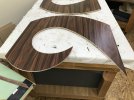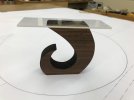Willem, the problem with precat lacquers is they look like plastic (because they basically are). Not everyone wants quick plastic wood look finishes.It doesnt give any depth to a wooden piece. Nor do we need a gallon of a certain finish generally. Im guessing the problem here was some odd chemical reaction with the wood and sealer because GF makes some of the finest finishing products available. Especially their new waterborne products, they are outstanding. Many dry as fast as precat lacquers also.
I normally don’t use precat, this was a rush job no time to order in. It is really hard to beat the look of Campbells 2K Urethane with anything else for clarity and depth. CV is a very close second. Not a Sherman Williams fan, but their Acrylic Conversion coating looks pretty good also. General Finishes makes a precat also, have never tried any of their products.
We can’t afford to play around with shellac sealers or finishes, first there is a durability issue and second the job time needed is multiple more hours. Waterborne has come a long way, but drying times are still slower and sanding the wash or seal coat remains difficult in terms of the time needed.
I’m not sure where the “plastic” perception of precat comes from? It is basically a nitro with a catalyst reaction and will always look better than poly urethane. 95% of the mass production industry use precat. We are a dealer for Bridgewood, which is really high end, their drawer boxes are available in walnut, which sounds crazy, but that is what some customers want. There is absolutely no plastic look on their precat finishes.
Pre-cat is basically nitro (cellulose from cotton and wood pulp) with urea added and fast drying solvents using an acid catalyst. (Think epoxy) There are no plastic (polyolefins)
For a piano or guitar finish, good old nitro still remains the industry standard. That is what Gibson uses.
The automotive industry has switched to urethanes and their clear coats will look just as good as Campbells 2K, on wood. The problem is a high end PPG coating can cost up to $150 a pint for the small guy.
Linky
There are several different types of lacquers available to woodworkers. Understanding their characteristics will help you choose the right one.

www.finewoodworking.com



